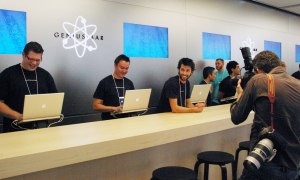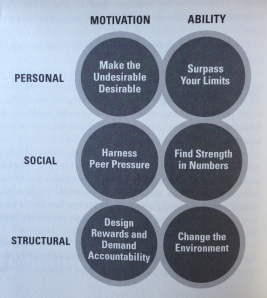Over the past few months, I’ve written about using social tools and practices to save money, about a framework for influencing behavior, and about applying the Fun Theory at work.
Today, I want to describe a project I’m working on to show how you can tie all those ideas together, unlocking value and enthusiasm even for mundane corporate goals.
The mundane corporate goal
One way firms can save money is by having people use their own mobile device instead of corporate-owned Blackberries. (Usually referred to as BYOD or Bring Your Own Device.) In a large firm, there could be many thousands of corporate mobiles and the costs could easily be tens of millions every year.
But how would you get people to use their own device instead?
What your firm might normally do
Normally, you would just change the policy: “We will no longer issue devices or reimburse employees for mobile expenses.”
You’d still want employees to have mobile access to work, though. So you might accompany your policy change with an awareness campaign, making sure everyone knew about the change and asking for their cooperation.
A different approach: A Genius Bar in every building
Changes to policy are powerful and raising awareness is important. But you can get better results – and do less damage to employee engagement – with an approach that taps into all of the 6 sources of influence described in “Influencer” by Kerry Patterson et al.
So we decided to try something different and more positive. We noticed how many people loved using their iPad for work once they got it set up and how they were often eager to help others. What if we could somehow connect those people and form a social movement that drove adoption while reducing costs?
“A Genius Bar in every building” started as a blog post on our social collaboration platform. It described how local volunteers could staff pop-up Genius Bars and help people set up their iPhones and iPads. Over the next few days, others contributed ideas and offered to volunteer. Soon, we had organized our first 2 events.
The initial events weren’t smooth or professional, but we learned a lot. And we were struck by how grateful everyone was. (“Thank you so much for doing this!”) Afterwards, one of the volunteers wrote about what could have gone better. Another person wrote down detailed instructions for future events. Someone else started an online sign-up sheet for volunteers in every location.
Now, we have events planned in a growing number of buildings all around the world. People are continuing to contribute suggestions for improving things. And with each event, we create more positive stories, attract more volunteers, and expand the movement.
Applying the Influencer Checklist
Is this all we can do? In using the Influencer checklist, we see the Genius Bars help us in 4 ways:
☑ Personal Ability: Having mobile experts in each lobby makes it convenient for people to enable their devices.
☑ Social motivation: Seeing a crowd gathered around an Apple logo can go a long way to motivate others to join. We also use the social collaboration platform to share stories of how other people at all levels are using their own devices.
☑ Social ability: By crowd-sourcing volunteers, we build up a network of experts who could help people locally and complement the small team of mobile engineers.
☑ Structural ability: A simple physical thing like having a “Blackberry Bin” makes it easier for people to give back their devices.
To tap into all 6 sources of influence, we’ll still need to change the policy to help with structural motivation – e.g. changing the reimbursement policies over time so it becomes increasingly unattractive to use a corporate device. We’re not doing enough to appeal to those who aren’t personally motivated to give up their corporate Blackberry. (Perhaps the “Speed Camera Lottery” from last week’s post might be applicable here.)
We have a choice
The point is that even for something as mundane as reducing mobile costs at work, we have a choice:
We can rely on crude carrots and sticks to change behavior.
Or we can care.
Care about the people affected. Care about producing more sustainable results. Care enough to try something different so we can make work more effective and more fulfilling.




What strikes me here is that there’s a lot of great face to face meaningful relationship building that couldn’t have happened without an offline, asynchronous collaboration mechanism like enterprise social. If I’m reading the post correctly.
John, it would be interesting to read more about how you got from the initial blog post to the point of the first 2 events.
Thanks, Sam. I might turn your suggestion into a separate post as taking the idea from blog to a global movement shows how to apply several different concepts I’ve written about previously. Thanks for the idea!
Another good post John. The final comment, “or we can care” is the real big one for me. Organizations continue to seek another type of carrot or stick as you note when simply caring about employees and trying different ideas can go a long way to better, more effective behaviors.
I am personally excited about getting our Genius Bar established. We’ve made significant progess and we should have it off the ground in NC within the next few weeks.It gives those of us that are,passionate about being “green” a great opportunity to collaborate and share our knowledge about technology and creative ways to help reduce our eco-foot print.
The beginning of a whole new relationship with IT.. next up, HR.
I’m working on it, Joachim. I’m working on it. 🙂
Great post John and very thought provoking. So apologies in advance but I’m applying keypad to blog!
As I read it (please correct me if I’m wrong) , there are two elements to this discussion
-BYOD and
-the activity you used to raise awareness and influence behaviour about this particular issue (but could be applied to others?)
BYOD is a hot topic, certainly, for most organisations and I have read as many arguments against as for, along the way. There are a number of reasons why people are still not motivated to give them up – some of which you touch upon: E.g Many organisations still have no proper structure in place for reimbursement of cost for using your own device – or seem unable to say what it might be without increasing cost to the organisation in terms of administration. Who is subsidising whose profits anyway?
Then there are issues over security, licensing and legal questions around data to mention a few – that leave IT departments wondering if short term gain is in fact very long term pain for organisations, if it is not managed properly.
If I saw a “BB bin” as I walked in to work I would skip over to it throwing my BB in without hesitation – but mainly because I dislike the device rather than what I use it for – “work” – pure and simple – and when I’m away from the office.
By using your own device for both work and personal it can become difficult to separate one from the other as they become entangled in a web of “I’m available 24/7” . But are you available to the right people at the right time when they need you?
But the debate should not distract from your key message -the method used to try and change behaviour – your pop-up genius bars – which was a really inspired activity !– for all the reasons you give and for the influencers you tapped in to, to drive adoption. And because the scheme was able to harness those influences the change in behaviour is likely to be more far reaching and above all long lasting – unlike the more “fun” examples of last week
Working in a more sustainable way goes without saying for business today, and trying different things to achieve it – essential!
What we need to be mindful of however is that whilst trying to make work “more effective” and “more fulfilling” we don’t make it “more all-consuming” at the same time.
Does that mean we don’t care?
Thanks, Marie-Louise. You’re right that BYOD is just an example but a practical one given there are projects like it at most firms.
I find using my personal device actually *less* intrusive than using a separate corporate device. Perhaps toting around a separate physical reminder with its own blinking red light is simply more of a burden for me.
In using my iPad for work, for example, I don’t get work notifications and so I only check work when I choose. It’s still easy to lose my work-life balance, but slightly less so than before for me.
Now, more interestingly, to apply the concepts to other, bigger problems!
Another great post John – certainly something to think about. But as I read this, I realised that we had a version of this about 6-7 years ago – it was called a local IT department! Always on hand to instal new software, help out with any niggles and would get you up and running on PCs or laptops! By centralising the IT department more people feel left to get on with it on your own, and if you are not by nature very techie, then work can be a real chore before you even think about doing the job you’re being paid for!
My company did this – the great centralisation, HR, IT, building maintenance etc. but there seems to be a shift in thinking. We already have a local HR representative to support the managers – may just be a matter of time before the IT comes back to site!
Then again, this is proof that if something that is needed is not being provided for by the company, then people will find ways around it. I’m going to BYOD this week, as I’m presenting a short session about video in learning, but I have to bring my own laptop as youtube is blocked…;-)
Hello, Damian. What you describe are different service models (and many feel your pain!).
But CoPs are communities of people who are connected by their craft as opposed to just people who work closely together. So, to use your example, those IT service professionals might belong to a Desktop Support CoP where they would learn while contributing to advance the state of their practice.
Makes sense?
Pingback: The best innovation program isn’t a program at all | johnstepper
Have you got an update on how this approach has worked out in practice. I loved the idea when I first read about it, but have been struggling to convince sceptical colleagues that it is preferable to introducing all sorts of draconian restrictions on BYOD.
We saw a significant uptick over 3 months (around 50% more users).
I think it complements policy change. I suggest starting with this approach to get more people familiar with the offering and give them a chance to adopt. (Why would you alienate people who would have used the service anyway?)
At some point, you come against people who simply won’t use the service because they don’t want a password or they want a separate phone number. Those people you will only get to adopt via policy.
Taking the long view, I say use a more customer/friendly approach to avoid unnecessarily giving the firm (particularly IT) a black eye and angering staff. Then take more aggressive steps. Now, when you implement policy, you’ll have all your early adopters helping spread the word about how good the service is.
It reminds me of broadband access about 10-15 years ago. We slowly weaned people off of that.